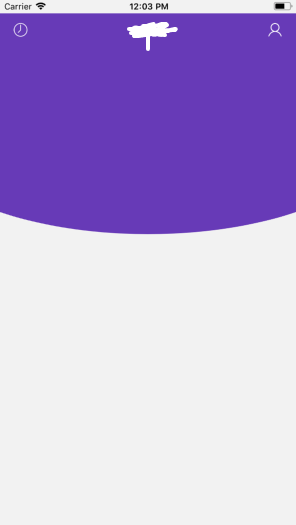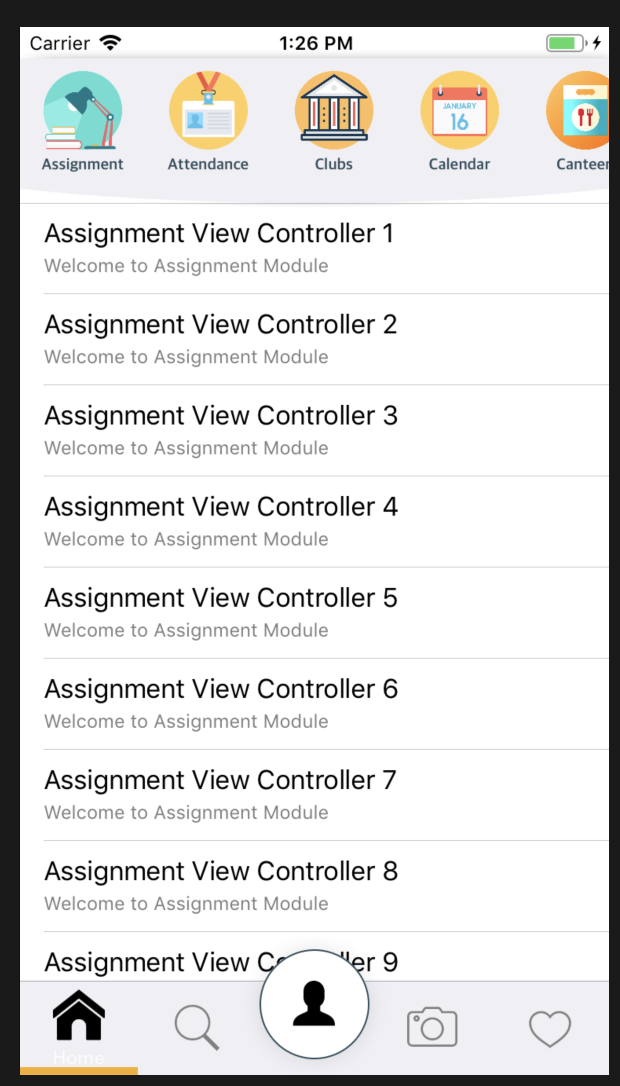-
-
Save anitaa1990/dd531515427cdecf80560a76f08cc870 to your computer and use it in GitHub Desktop.
| import UIKit | |
| extension UIView { | |
| /* Usage Example | |
| * bgView.addBottomRoundedEdge(desiredCurve: 1.5) | |
| */ | |
| func addBottomRoundedEdge(desiredCurve: CGFloat?) { | |
| let offset: CGFloat = self.frame.width / desiredCurve! | |
| let bounds: CGRect = self.bounds | |
| let rectBounds: CGRect = CGRect(x: bounds.origin.x, y: bounds.origin.y, width: bounds.size.width, height: bounds.size.height / 2) | |
| let rectPath: UIBezierPath = UIBezierPath(rect: rectBounds) | |
| let ovalBounds: CGRect = CGRect(x: bounds.origin.x - offset / 2, y: bounds.origin.y, width: bounds.size.width + offset, height: bounds.size.height) | |
| let ovalPath: UIBezierPath = UIBezierPath(ovalIn: ovalBounds) | |
| rectPath.append(ovalPath) | |
| // Create the shape layer and set its path | |
| let maskLayer: CAShapeLayer = CAShapeLayer() | |
| maskLayer.frame = bounds | |
| maskLayer.path = rectPath.cgPath | |
| // Set the newly created shape layer as the mask for the view's layer | |
| self.layer.mask = maskLayer | |
| } | |
| } |
anitaa1990
commented
Mar 31, 2018
•

getting that shadow only for the curve edge as you can see modified your code little bit but was not able to achieve
`func addBottomRoundedEdge(desiredCurve: CGFloat?,borderColor: CGColor) {
let offset: CGFloat = self.frame.width / desiredCurve!
let bounds: CGRect = self.bounds
let rectBounds: CGRect = CGRect(x: bounds.origin.x, y: bounds.origin.y, width: bounds.size.width, height: bounds.size.height / 2)
let rectPath: UIBezierPath = UIBezierPath(rect: rectBounds)
let ovalBounds: CGRect = CGRect(x: bounds.origin.x - offset / 2, y: bounds.origin.y, width: bounds.size.width + offset, height: bounds.size.height)
let ovalPath: UIBezierPath = UIBezierPath(ovalIn: ovalBounds)
rectPath.append(ovalPath)
let maskLayer: CAShapeLayer = CAShapeLayer()
maskLayer.frame = bounds
maskLayer.path = rectPath.cgPath
maskLayer.shadowColor = borderColor
maskLayer.shadowOpacity = 10.0
self.layer.mask = maskLayer
self.layer.borderWidth = 0
self.layer.borderColor = borderColor
}`
Please how can i inverse the curvature?
Did anyone figure out shadow only on the curve edge?
Do you know how to inverse the curvature?
func addTopRoundedCornerToView(targetView:UIView?, desiredCurve:CGFloat?)
{
let offset:CGFloat = targetView!.frame.width/desiredCurve!
let bounds: CGRect = targetView!.bounds
let rectBounds: CGRect = CGRect(x: bounds.origin.x, y: bounds.origin.y+bounds.size.height / 2, width: bounds.size.width, height: bounds.size.height / 2)
let rectPath: UIBezierPath = UIBezierPath(rect: rectBounds)
let ovalBounds: CGRect = CGRect(x: bounds.origin.x - offset / 2, y: bounds.origin.y, width: bounds.size.width + offset, height: bounds.size.height)
let ovalPath: UIBezierPath = UIBezierPath(ovalIn: ovalBounds)
rectPath.append(ovalPath)
// Create the shape layer and set its path
let maskLayer: CAShapeLayer = CAShapeLayer()
maskLayer.frame = bounds
maskLayer.path = rectPath.cgPath
// Set the newly created shape layer as the mask for the view's layer
targetView!.layer.mask = maskLayer
}
great job
How I can make it from the left side I tried this code but it's appeared on the right
`func addLeftRoundedEdge() {
let offset: CGFloat = (self.frame.height * 1.5)
let bounds: CGRect = self.bounds
let rectBounds: CGRect = CGRect(x: bounds.origin.x, y: bounds.origin.y, width: bounds.size.width/2 , height: bounds.size.height)
let rectPath: UIBezierPath = UIBezierPath(rect: rectBounds)
let ovalBounds: CGRect = CGRect(x: bounds.origin.x , y: bounds.origin.y - offset / 2, width: bounds.size.width , height: bounds.size.height + offset)
let ovalPath: UIBezierPath = UIBezierPath(ovalIn: ovalBounds)
rectPath.append(ovalPath)
let maskLayer: CAShapeLayer = CAShapeLayer()
maskLayer.frame = bounds
maskLayer.path = rectPath.cgPath
self.layer.mask = maskLayer
}`
for people trying to add a shadow to this, i was able to do it by using a second view
class CurvedWithShadowView: UIView {
private let shadowView = UIView()
private let curvedView = UIView()
init() {
super.init(frame: .zero)
shadowView.backgroundColor = .none
shadowView.configureForAutoLayout()
curvedView.backgroundColor = .white
curvedView.configureForAutoLayout()
addSubview(shadowView)
addSubview(curvedView)
configureForAutoLayout()
setNeedsUpdateConstraints()
}
required init?(coder: NSCoder) {
fatalError("init(coder:) has not been implemented")
}
// this is using "PureLayout" you could do the same with plain auto layout too
override func updateConstraints() {
shadowView.autoPinEdge(toSuperviewEdge: .top)
shadowView.autoPinEdge(toSuperviewEdge: .bottom)
shadowView.autoPinEdge(toSuperviewEdge: .left)
shadowView.autoPinEdge(toSuperviewEdge: .right)
curvedView.autoPinEdge(toSuperviewEdge: .top)
curvedView.autoPinEdge(toSuperviewEdge: .bottom)
curvedView.autoPinEdge(toSuperviewEdge: .left)
curvedView.autoPinEdge(toSuperviewEdge: .right)
super.updateConstraints()
}
override func layoutSubviews() {
let offset: CGFloat = frame.width / 0.5
let mask: CAShapeLayer = CAShapeLayer()
let rectBounds: CGRect = CGRect(x: bounds.origin.x, y: bounds.origin.y + bounds.size.height / 2, width: bounds.size.width, height: bounds.size.height / 2)
let rectPath: UIBezierPath = UIBezierPath(rect: rectBounds)
let ovalBounds: CGRect = CGRect(x: bounds.origin.x - offset / 2, y: bounds.origin.y, width: bounds.size.width + offset, height: bounds.size.height)
let ovalPath: UIBezierPath = UIBezierPath(ovalIn: ovalBounds)
rectPath.append(ovalPath)
mask.frame = bounds
mask.path = rectPath.cgPath
curvedView.layer.mask = mask
shadowView.layer.shadowPath = rectPath.cgPath
shadowView.layer.shadowColor = UIColor.black.cgColor
shadowView.layer.shadowOpacity = 0.15
shadowView.layer.shadowOffset = .zero
shadowView.layer.shadowRadius = 4.0
}
}


